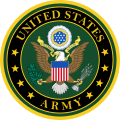Applicable Army regulations

Army Technical Bulletin 43-0209, Color, Marking, and Camouflage Painting of Military Vehicles, Construction Equipment and Materials Handling Equipment, standardizes how vehicle bumper numbers are applied. The markings are divided into four positions. Positions 1 and 2 are applied on the left, while positions 3 and 4 are applied on the right. The positions identify
- The major command, organization or activity the equipment is associated with;
- The intermediate organization or activity;
- The unit that operates and maintains the vehicle; and
- The specific vehicle number (often associated with the order of march).
Anything beyond this policy such as assigning a specific number against a specific unit position is a matter of unit standard operating procedure. However, the number six has traditionally been associated with the commander of the element. For example, a Humvee assigned to the commander of Charlie Company would be designated "C06," while the 1st Platoon, Charlie Company's command vehicle would be "C16," 2nd Platoon would be "C26," etc. [2]
Army Technical Bulletin 43-0139, Painting and Instructions for Army Materiel, gives information about applying ID markings over camouflage colors. Black lettering must be used over brown or green paint, green lettering over black paint, and brown lettering over white or tan paint. There are only two authorized methods of making bumper numbers: using adhesive vinyl (stickers) and paint.
Army Regulation 750-1, Army Materiel Maintenance Policy, allows MACOM commanders to conceal bumper numbers in tactical conditions. Overseas commanders may comply with international agreements regarding vehicle bumper numbers. Some overseas commands paint solid light color rectangular boxes as the background for bumper numbers.
